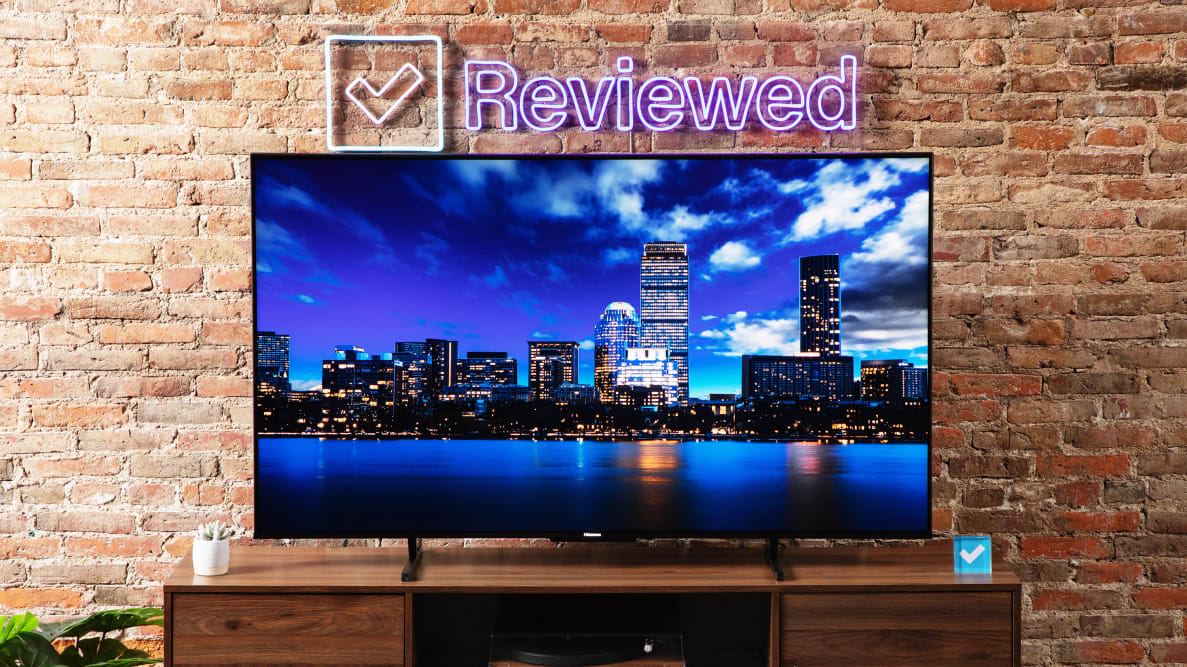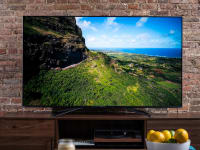Pros
-
Incredibly bright and colorful
-
Superb local dimming
-
Long list of gaming features
Cons
-
Only two HDMI 2.1 inputs
-
Quirky picture processing
-
Narrow viewing angle for most sizes
Not only is the U8K one of the brightest TVs we’ve seen all year, its local dimming is shockingly good. It features bright, voluminous color, a dependable smart platform, and a long list of gaming-related features, including VRR and support for 144Hz gaming.
But most of its gaming features are limited to two HDMI inputs, and one of them also serves as the eARC-enabled port. Like most mini-LED TVs, the U8K series (apart from the 75-inch version) looks worse during off-axis viewing, and Hisense still hasn’t completely ironed out some processing-related performance quirks visible on its TVs for a few years now.
Still, for folks shopping for a high-end TV at a price lower than most flagships, the U8K is a fantastic option. It’s a TV for people who want $2,000 performance without needing to pay that much for the privilege.
About the Hisense U8K
The Hisense U8K is available in four sizes ranging from 55 to 85 inches. Our review unit is a 65-inch model we received on loan from Hisense.
In recent years, Hisense TVs have seen discounts right as they hit shelves. Hisense refers to these prices as the “everyday price.” For example, the 55-inch U8K carries an MSRP of around $1,300, it’s currently on sale for about $750. While it’s possible that this price fluctuates in the coming months, we don’t expect it to jump up above $750 anytime soon, if ever.
Here’s how the series shakes out:
- 55-inch (Hisense 55U8K), MSRP $1,299.99 (currently $749.99)
- 65-inch (Hisense 65U8K), MSRP $1,699.99 (currently $1,049.99)
- 75-inch (Hisense 75U8K), MSRP $2,299.99 (currently $1,499.99)
- 85-inch (Hisense 85U8K), MSRP $2,999.99 (everyday price of $2,299.99)
At the time of publishing, the 85-inch model is not yet on sale. According to Hisense, it should be available at the end of August or early September.
The 55-, 65-, and 85-inch versions of the U8K feature VA-style panels, while the 75-inch model uses an ADS-style panel. VA panels tend to offer better deeper black levels at the expense of a wider viewing angle, while ADS panels trade deeper black levels for better off-axis performance. You can learn more about VA and IPS/ADS panels in our guide to TV panel types.
Each size variant within a mini-LED TV series features a different amount of dimming zones. A difference in zone count could spell slight differences in how a TV performs. However, while bigger sizes in an mini-LED TV series usually feature a higher number of dimming zones, the number of zones increase proportionally to a TV’s size.
Here are the number of dimming zones for each size as provided by Hisense:
- 55-inch: 672 dimming zones
- 65-inch: 1,008 dimming zones
- 75-inch: 1,056 dimming zones
- 85-inch: 1,296 dimming zones
Hisense U8K specs
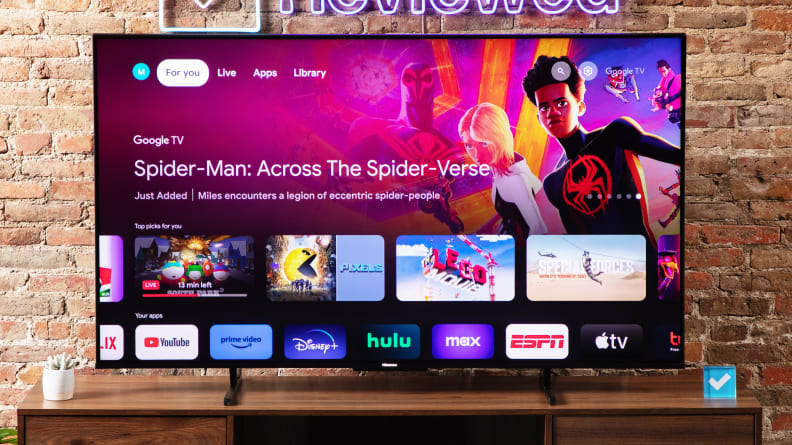
The U8K's processing speed help Google TV OS run quickly.
- Resolution: 4K (3,840 x 2,160)
- Display type: Mini-LED with quantum dots
- HDR support: Dolby Vision, HDR10+, HDR10, HLG
- Dolby Atmos: Yes
- eARC support: Yes
- Color: DCI-P3 color space/8-bit plus frame rate control (FRC)
- Native refresh rate: 120Hz/144Hz with VRR
- Smart platform: Google TV
- Variable Refresh Rate (VRR): Yes
- Auto Low Latency Mode (ALLM): Yes
- ATSC 3.0 tuner: Yes
- Other features: AMD FreeSync Premium Pro, Filmmaker Mode, Game Mode, Amazon Alexa, Google Assistant, Google Chromecast, Apple AirPlay, Apple Home
The U8K’s design aesthetic is basic, but nothing disappoints other than the rudimentary remote control, whose rounded shape causes it to rock on surfaces. The big, squishy buttons don’t exactly scream sophistication, either.
From a design standpoint, the TV’s best feature is its pair of heavy, metallic feet. These offer plenty of room for a soundbar and can be positioned in a wide or narrow formation, depending on your media console.
The Google TV smart platform is integrated well, thanks in part to the U8K’s zippy processing speed. The platform itself is rather cramped with ads and recommended content, but this is the case for every smart platform other than Roku. Most importantly, Google TV offers a vast library of downloadable apps, so if you want to make it your daily driver, you can expect, at the very least, an accommodating experience.
Connectivity
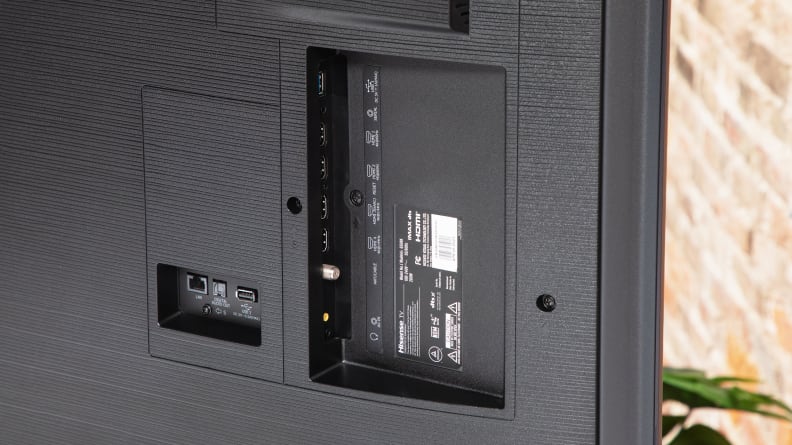
A closer look at the connection ports for the Hisense U8K.
The U8K offers plenty of connectivity options for most users, but A/V enthusiasts and dedicated gamers ought to take note that of the four HDMI inputs, two are 2.1 ports and two are 2.0.
Here’s what you’ll find in a side-facing cutout on the back of the panel:
- 2x HDMI 2.1 (4K @ 120Hz/144Hz, 1x HDMI ARC/eARC)
- 2x HDMI 2.0 (4K @ 60Hz)
- 2x USB (1x USB 3.0, 1x USB 2.0)
- RF connection (cable/antenna)
- Ethernet (LAN) input
- Composite audio input (with adapter)
- RS-232C
Performance Data
Before testing each TV, we make sure the panel is on and receiving a continuous signal for at least 2 hours. Our 65-inch U8K received this standard warm-up time before any readings were taken. In addition, the TV received the latest firmware updates at the time of testing.
For both SDR and HDR tests, we’re using Hisense’s Filmmaker picture mode. We’ve chosen this setting because of its accuracy, but performance may vary depending on which picture mode is enabled. For example, you might experience a brighter picture with a different mode enabled, but it may negatively affect color temperature and overall color accuracy.
To get a sense of the TV’s average performance, we use a standard ANSI checkerboard pattern for most of our basic contrast tests. We also use white and black windows ranging from 2% to 100% to test how well the contrast holds up while displaying varying degrees of brightness.
Our peak brightness measurements are taken with sustained windows ranging in size from 2% to 100% (full screen) to represent the TV’s peak brightness over a sustained period of time. Specular highlights (like brief flashes of reflected light) might reach higher brightness levels, but not for sustained periods of time.
All of our tests are created with a Murideo Seven 8K signal generator and tabulated via Portrait Displays’ Calman Ultimate color calibration software.
I'll expand on our test results throughout the review, but for now, here are some key takeaways:
- HDR contrast (brightness/black level): 851.6 nits/0.105 nits (ANSI checkerboard)
- SDR contrast (brightness/black level): 861.4 nits/0.094 nits (ANSI checkerboard)
- HDR peak brightness (sustained): 2,067.55 nits (25% white window)
- HDR color gamut coverage (DCI-P3 1976 uv/10-bit): 95.57%
- HDR color gamut coverage (BT.2020 1976 uv): 79.8%
- SDR color gamut coverage (Rec.709): 99.7%
Before testing, I ensured that the HDMI input in use was set to its Enhanced format. I also disabled the TV’s Automatic Light Sensor in each of the inputs I used throughout my testing. This toggle can be found in the TV’s General picture menu.
For all tests, I used the U8K’s Warm1 Color Temperature, set the Local Dimming to High, and disabled the following settings: Active Contrast and Dark Detail (located within the Brightness submenu), Super Resolution, Smooth Gradient, Noise Reduction, Motion Enhancement, and Motion Clearness (located within the Clarity submenu).
For HDR tests, Dynamic Tone Mapping was disabled.
What we like
Dazzling brightness and impressive backlight control
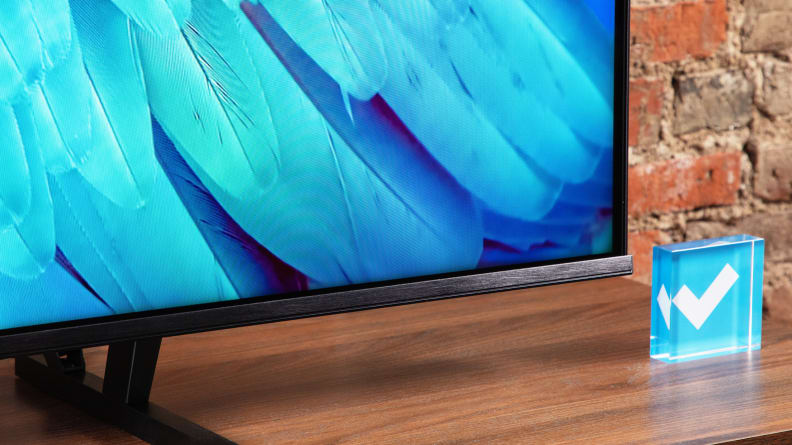
The Hisense U8K has spectacular brightness, eclipsing 2,000 nits.
The U8K is one of the brightest TVs we’ve tested all year. We’ll see how it stacks up against Samsung’s mini-LED TVs (one of which we’re currently evaluating), but it’s nearly twice as luminous as the Sony X93L and on par with the TCL QM8. If you’re shopping for a bright living space (or you’re just chasing brain-melting brightness), the U8K should definitely be in the mix.
It’s not just small, intensely bright HDR highlights that dazzle (though it certainly renders those brilliantly). The U8K is bright all the time, even if you’re clicking through the channels on a Sunday afternoon. For SDR content (which represents most of what’s available on cable, OTA antennas, YouTube, and various streaming services), the U8K has an average picture brightness of around 800 to 900 nits. For reference, that’s about twice as bright as the U8K’s lower-end cousin, the Hisense U6K. This added oomph is the one of the biggest reasons to spend up on the U8K.
Specular highlights are sensationally bright, regularly cresting the 2,000-nit mark. During testing, I found myself transfixed by these highlights: the glittering reflections on a sun-dappled ocean, for instance, or a shower of cascading sparks during an action set piece in Batman.
Its high-octane brightness is buttressed by deep black levels and terrific backlight control. In fact, the U8K’s excellent contrast is one of the most impressive aspects of its performance, second only to its high nit count. Hisense has made fantastic use of mini-LED backlighting with the U8K. Its plethora of zones and well-disciplined local dimming limit common issues like blooming to a barely perceptible level.
Watching a show or movie with subtitles? No problem. The U8K does a remarkable job of reining in the luminance of the words on the screen, even during content with a dark color palette (like Netflix’s 1899). The backlight control was highly commendable across all of my go-to local dimming stress tests, be them generated patterns or notoriously difficult-to-render movie scenes.
When it comes to mini-LED backlight control, the U8K greatly outpaces the Sony X93L (a TV that’s currently $950 more than the U8K in the 65-inch class), but lags behind the TCL QM8 (a TV that’s about $250 pricier at the time of publishing). That’s seriously impressive for its price bracket.
Bright, bold quantum dot-color
When you combine quantum dots with a ridiculously powerful backlight system, you’re going to wind up with a colorful canvas. The U8K delivers a predictably vibrant palette, especially during HDR10 or Dolby Vision content. It covers about 97% of the HDR color gamut (DCI-P3), which puts it right in line with the other high-profile mini-LED TVs we’ve tested this year.
The TV’s most accurate picture mode, Filmmaker, is a little more polished in HDR than SDR, but its average color error (DeltaE) managed to stay under 3.5, with 3 representing the commonly accepted threshold of perceptible error for most people. Both the TCL QM8 and (especially) the Sony X93L offer better out-of-the-box accuracy, but casual observers are unlikely to see the difference outside of a direct side-by-side comparison.
Moments of bright, impactful color are where the U8K is at its best. It’s quite a treat to be bathed in the glow, whether it’s monochromatic (like the opening title cards of A Clockwork Orange) or kaleidoscopic (the finale of Spider-Man: Into the Spider-Verse).
There are enough features for most gamers, but…
Hisense has hopped on board the higher-than-high refresh rate bandwagon: The U8K is one of several higher-end TVs offering a 144Hz refresh rate for PC gamers who want to take the action to a big screen. It also supports native 4K gaming at 120Hz, AMD FreeSync Premium Pro (for extra-smooth gaming), and the requisite Auto Low Latency Mode, which automatically optimizes the U8K for gaming when it detects a console.
With such a punchy, colorful picture, current-gen games will be a feast for the eyes. For Xbox owners, the U8K’s Dolby Vision support is a minor point in its favor over a Samsung mini-LED, and given its superior local dimming over the Sony X93L, it’s a better-looking option for darker games with bright HUDs.
Unfortunately, there’s a catch.
What we don’t like
...One of its gaming inputs is pulling double duty
Some of the U8K’s aforementioned gaming features (including 4K/120Hz/144Hz support) are limited to two of the TV’s four HDMI inputs, and one of those inputs also serves as the TV’s eARC input.
Why is that an issue? Well, if you own an Xbox Series X, a PlayStation 5, and an eARC-enabled soundbar, one of your consoles is going to have to live on an input that isn’t optimized for gaming. You could, of course, play “musical inputs” and constantly swap HDMI cables, but what kind of life is that? Buying an A/V receiver is an option, too, but those cost money.
Now, to be fair, the U8K isn’t the only mini-LED TV in or above its price bracket with this issue. The Sony X93L is a step above the U8K in price and organizes its inputs similarly.
If you want to lock down a new mini-LED TV that offers full-bandwidth HDMI 2.1 support across all of its inputs—and perhaps save yourself years of hand-wringing whenever a new gaming device is released—you have a couple of options. A Samsung mini-LED TV (like the QN90C or the QN95C) will get you there, but it’ll cost considerably more than a U8K. (Once again, money!)
The TCL QM8, on the other hand, is perfectly positioned to be the compromise candidate. It, too, is limited to two gaming-optimized inputs, but its eARC input is not one of its dedicated gaming inputs. If you own two consoles and a soundbar, you’re good to go. The QM8 is only a touch more expensive than the U8K (though it’s not available in a 55-inch variant). Gamers, you’ve got some soul-searching to do.
Narrow viewing angle
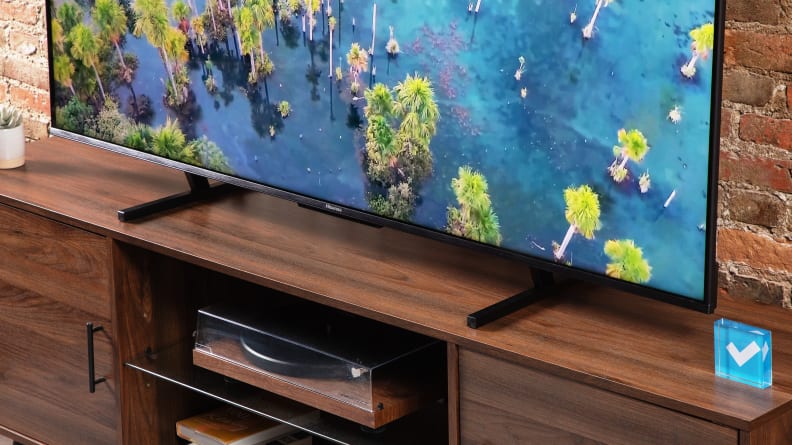
Viewing from an angle causes contrast to drop and colors to look washed out.
As with every mini-LED TV I’ve tested this year, the U8K’s picture quality takes a hit if you park yourself at an off-axis position. Once you cross roughly the 40°-mark on either side of the screen, the most dazzling aspects of the picture start to fade away.
You will notice more blooming around bright objects if you’re sitting off to the side, but honestly, I was kind of impressed with how well the U8K deals with that issue, especially compared to the Sony X93L. However, there’s a noticeable drop in contrast and colors start to look washed out, especially in SDR.
It’s important to keep in mind that our 65-inch U8K is using a VA-style panel, which trades off-axis performance for improved contrast. As noted, the 75-inch U8K uses an ADS panel, which could offer a wider viewing angle than the 55-, 65-, and 85-inch models.
Picture processing is improved, but sometimes things just look quirky
For this next section, I’m going to try and be as careful with my words as possible, for two reasons: First, if I haven’t made it clear yet, the U8K is not only a great TV for the price, it’s a great TV, period. Second, most folks who look at this TV won’t notice these quirks. In fact, I myself lost sight of them from time to time, usually when the picture was bright and colorful (otherwise known as a typical viewing condition).
I believe Hisense has made significant improvements to its picture processing year over year. The U8K (and the U6K, for that matter) feature better upscaling than their predecessors (the U6H and the U8H), and there is much less motion-induced red color fringing, too.
But the color fringing isn’t completely gone. Now, at this point I’m basically looking for it and it will likely be the first thing I look for when I evaluate the U7K. It’s not something that’s immediately jumping out at me at all times, and I appreciate that a real improvement has been made on this front. But there are moments where I can still see it, subtle though it may be.
The edges of faces, characters’ hairlines, and along the edges of hands in motion is where it happens most, especially if a dimly lit scene is using warm lightning to illuminate characters (a sequence in the boiler room of a ship in 1899 comes to mind). Occasionally, a lingering frame of a fast-moving object will leave behind an orange-red smear.
I also find that most HDR content (including 4K Blu-rays watched on our Oppo UDP-203) look a touch fuzzy on the U8K compared to other mini-LED TVs I’ve tested recently. It’s tough to explain, but sometimes, things just look… off.
The U8K’s spectacular contrast and color aside, I prefer the visual expression of the TCL QM8 and the Sony X93L (although I still prefer the U8K’s excellent local dimming, despite Sony’s superior picture processing). But the QM8 is neck-and-neck with the U8K in several performance categories, and while TCL’s processing isn’t as impressive as Sony’s, it shows how high brightness and excellent local dimming are elevated by well-engineered picture processing.
Should you buy the Hisense U8K?
Yes, especially if you want to stretch your dollar on performance
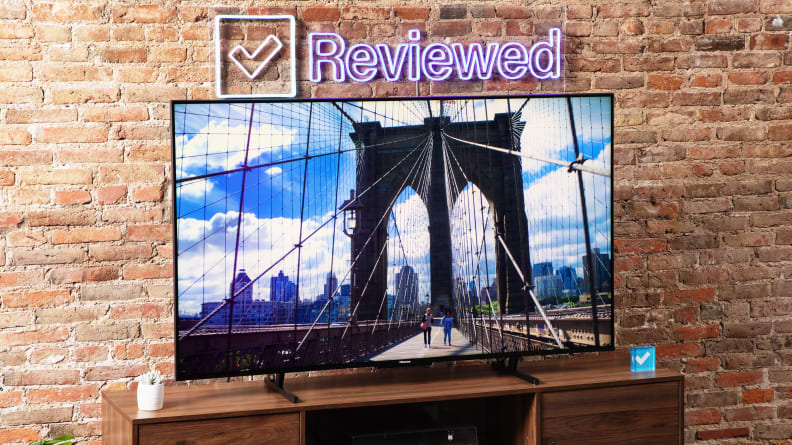
The Hisense U8K offers incredible performance for its price.
Even if you set aside its value-forward price, the U8K is one of the best TVs Hisense has ever made. Once you wrap your head around the fact that the 55-inch version starts at around $750, the U8K’s “wow” factor really comes into focus.
The QM8’s input suite is friendlier to gamers, its local dimming is better than any mini-LED TV I’ve seen this year, and I prefer TCL’s processing technology over Hisense’s. Personally, I’d find it difficult to pass on the QM8, but it’s not available in a 55-inch option, and it’s pricier than the U8K. For many people, that’s enough of a reason to go with the Hisense.
Perhaps the U8K’s most noteworthy success is how well it stacks up against the Sony X93L, a similarly spec’d TV that’s pricier by an order of magnitude. Yes, Sony’s software implementation, its processing (and especially upscaling) are unmatched, but its local dimming is nowhere near as precise as the U8K’s, to say nothing of its brightness.
The U8K is a significant improvement over its predecessor, and one of the best TVs of the year. These would be my key takeaways if it was several hundred dollars more expensive than it is. The fact that it’s not is kind of remarkable.

The Hisense U8K is one of this year's best TVs, offering excellent performance for the price.
Buy at AmazonMeet the tester
Michael Desjardin graduated from Emerson College after having studied media production and screenwriting. He specializes in tech for Reviewed, but also loves film criticism, weird ambient music, cooking, and food in general.
Checking our work.
Our team is here for one purpose: to help you buy the best stuff and love what you own. Our writers, editors, and lab technicians obsess over the products we cover to make sure you're confident and satisfied. Have a different opinion about something we recommend? Email us and we'll compare notes.
Shoot us an email
